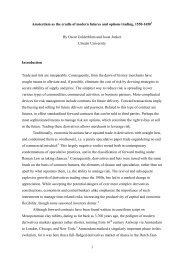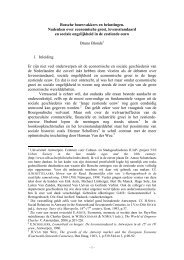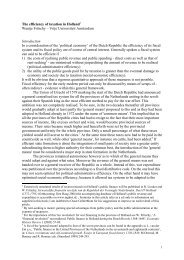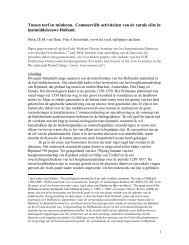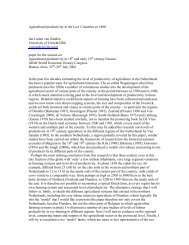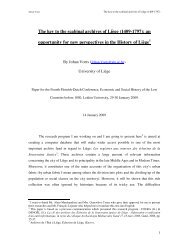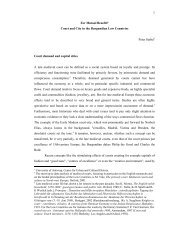Justyna Wubs-Mrozewicz LOOKING TWICE - Economy and Society ...
Justyna Wubs-Mrozewicz LOOKING TWICE - Economy and Society ...
Justyna Wubs-Mrozewicz LOOKING TWICE - Economy and Society ...
Create successful ePaper yourself
Turn your PDF publications into a flip-book with our unique Google optimized e-Paper software.
Looking twice, <strong>Justyna</strong> <strong>Wubs</strong>-<strong>Mrozewicz</strong> January 2009<br />
dealt with a case where there was continuity, not change in the commercial balance. 4 In<br />
Bergen, the mercantile capital of (Late) Medieval Norway, Hansards maintained the grip on<br />
the foreign trade until at least the end of the sixteenth century. This fact has until now been<br />
omitted in most of the analyses of the general Holl<strong>and</strong>ish-Hanseatic relations. All the external<br />
factors which boosted the Holl<strong>and</strong>ish position in the Baltic, seem to have played no role in<br />
Bergen. It must be pointed out here that even though Bergen at first sight appears to have<br />
been on the outskirts of commerce in Late Medieval <strong>and</strong> Early Modern Europe, in reality it<br />
was both geographically <strong>and</strong> commercially a vital economic hub. The seat of one of the four<br />
major Hanseatic Kontore, Bergen was the staple market of stockfish coming from northern<br />
Norway. 5 And stockfish (dried cod) was a commodity which became a hit product with<br />
medieval consumers in the age of urbanisation. 6 The qualities of stockfish, especially its<br />
durability, 7 made it also a product which attracted continuous interest of foreign traders,<br />
amongst them Hansards <strong>and</strong> Holl<strong>and</strong>ers. 8 Like Baltic grain, Norwegian stockfish became one<br />
of the major bulk commodities in Hanseatic <strong>and</strong> European commerce. 9 If the same groups of<br />
traders were active in these two branches of trade, why was there no similar shift in<br />
dominance in Bergen like there was in the Baltic? In the following, I will argue that local<br />
conditions played a crucial role in the definition of the commercial st<strong>and</strong>ing of foreign<br />
traders. Especially three factors were of importance: the framework of the commercial<br />
privileges granted by Norwegian rulers; the so-called credit system in Bergen; <strong>and</strong> the<br />
manner of organisation of Hansards <strong>and</strong> Holl<strong>and</strong>ers in Bergen.<br />
4 <strong>Wubs</strong>-<strong>Mrozewicz</strong>, Traders, Ties <strong>and</strong> Tensions.<br />
5 As well as Icel<strong>and</strong> until the beginning of the fifteenth century, <strong>and</strong> the tributary isl<strong>and</strong>s isl<strong>and</strong>s of Shetl<strong>and</strong>,<br />
Orkney <strong>and</strong> the Føroyar (Faeroes). See Helle, Bergen I, pp. 64 <strong>and</strong> 346-353; <strong>Wubs</strong>-<strong>Mrozewicz</strong>, ‘Fish, Stock <strong>and</strong><br />
Barrel. Changes in the Stockfish Trade in Northern Europe c. 1360-1560’.<br />
6 Lampen, ‘Stadt und Fisch’, pp. 281-307; P. van Dam <strong>and</strong> M. van Winter, ‘Theorie en praktijk van eetregimes<br />
in de Middeleeuwen’, p. 407. The popularity of stockfish was reflected in its occurrence in many cookbooks<br />
across Europe, see <strong>Wubs</strong>-<strong>Mrozewicz</strong>, ‘Fish, Stock <strong>and</strong> Barrel. Changes in the Stockfish Trade in Northern<br />
Europe c.1360-1560’, p. 187.<br />
7 Stockfish consisted of up to 80 percent protein, see Kurlansky, Cod, p. 34, <strong>and</strong> could be preserved for up to<br />
three years retaining its quality, see Nedkvitne, Utenriksh<strong>and</strong>elen, p. 349; Ubbens, ‘Noorse kabejauwvissers en<br />
Nederl<strong>and</strong>se kooplieden’, p. 21; Perdikaris <strong>and</strong> McGovern, ‘Viking age economics <strong>and</strong> the origins of<br />
commercial cod fisheries in the North Atlantic’.<br />
8 Foreign stockfish merchants appeared in Bergen at the end of the twelfth century at the latest, <strong>and</strong> from the<br />
fourteenth century the export of fish was entirely in the h<strong>and</strong>s of foreigners. It remained so until the 1540s, when<br />
Bergen burghers became active in the stockfish trade, see Nedkvitne, Utenriksh<strong>and</strong>elen, pp. 18, 159-169;<br />
Schreiner, Hanseatene og Norge, pp. 115-183; Fossen, Bergen II, pp. 15-22.<br />
9 Dollinger, Die Hanse, p. 278; Boer, de ‘'Waermede sal men den cogge laden?' - Enkele aspecten van de laatmiddeleeuwse<br />
h<strong>and</strong>el in de Nederl<strong>and</strong>en, tot ca. 1470’; Hoffmann, ‘Frontier Foods for Late Medieval<br />
Consumers: Culture, <strong>Economy</strong>, Ecology’.<br />
2



